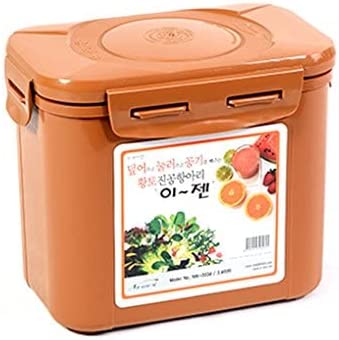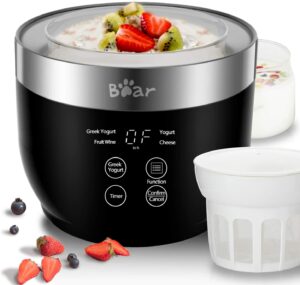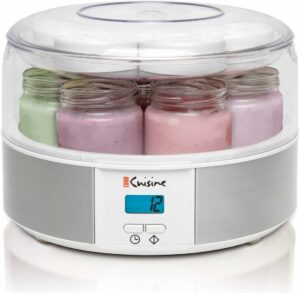Discover the world of how to make homemade probiotics for beginners as you better understand probiotics. There are online recipes galore – if you choose to search for them!
Here are three of our tried and tested recipes to improve your digestive health! But first, what are the basics?
Table of Contents
How to Make Homemade Probiotics – The Essentials
Making homemade probiotics can be a fun and rewarding project. For beginners, you don’t need many specialized items to get started, however, the specific equipment and ingredients you need will depend on the type of probiotic you want to make.
Whether it’s yogurt, kefir, sauerkraut, kimchi, or kombucha, you can find simple recipes online that outline the necessary items for each. Here are the general essential things you will need:
- Glass Jars or Fermentation Vessels: You’ll need clean and sterilized glass jars or fermentation vessels to culture your probiotics. Mason jars or glass containers with airtight lids work well. Weighted lids are sold separately. Make sure they are big enough to hold the ingredients and allow some space for expansion during fermentation.
- Fresh Ingredients: The main ingredients to make homemade probiotics are food that will be fermented and the probiotic culture or starter. For example, if you are making yogurt, you will need milk (dairy or plant-based) and a yogurt starter with live cultures.
- Probiotic Starter or Culture: To kickstart the fermentation process, you will need a probiotic starter or culture. This can be store-bought live-culture yogurt for yogurt making, a kefir starter for kefir, or a specific probiotic supplement for fermenting other foods. Make sure the starter contains live and active cultures.
- Clean Kitchen Utensils: Use clean and sanitized utensils to handle the ingredients and transfer them into the fermentation vessels. This helps prevent the growth of harmful bacteria and ensures a successful fermentation.
- Cheesecloth or Coffee Filter: For some probiotic recipes, like making kefir or kombucha, you may need a breathable cover for your fermentation vessels to allow airflow while preventing dust and debris from getting inside. Cheesecloth or coffee filters secured with rubber bands work well for this purpose.
- Rubber Bands: These are useful for securing the cheesecloth or coffee filter over the fermentation vessel.
- Labels and Marker: It’s a good idea to label your jars with the type of probiotic being fermented and the date it started. This way, you can keep track of the fermentation process and know when it is ready.
- Room Temperature: Most probiotics cultures thrive at a specific temperature range, typically around room temperature (70-75°F or 20-24°C). You don’t need any special equipment for temperature control, but keeping the jars in a stable environment away from direct sunlight and extreme temperature fluctuations is important.
- Patience: To make homemade probiotics requires some time to ferment and develop the desired flavors and probiotic content. Patience is key, as fermentation times can range from a few hours to several days or even weeks.
- OPTIONAL One Step Appliances: Let us face it, not everyone has the patience for fermentation! Fortunately, there are appliances available such as yoghurt makers.
Make Homemade Probiotics – Yoghurt Recipe
Yogurt is one of the most popular and accessible homemade probiotics. All you need is milk and a yogurt starter culture containing live active bacteria, such as Lactobacillus bulgaricus and Streptococcus thermophilus.
Simply heat the milk, cool it down, mix in the starter culture, and let it ferment at a controlled temperature for several hours.
The result is creamy, probiotic-rich yogurt that can be enjoyed plain or customized with fruits and toppings.
Ingredients
- 4 cups (1 liter) of milk (whole or low-fat, depending on your preference)
- 2 tablespoons of plain yogurt with live active cultures (as a starter)
Instructions
- Pour the milk into a large saucepan and heat it over medium heat. Stir occasionally to prevent scorching and ensure even heating.
- Heat the milk until it reaches a temperature of about 180°F (82°C) or until it starts to steam and small bubbles form around the edges. This helps kill any unwanted bacteria and proteins that can interfere with the yogurt-making process.
- Once the milk reaches the desired temperature, remove it from the heat and allow it to cool. You can speed up the cooling process by placing the saucepan in a cold water bath or by transferring the milk to a clean, heat-resistant container.
- Cool the milk until it reaches a temperature of around 110°F (43°C). You should be able to comfortably touch the milk without scalding your finger.
- While the milk is cooling, in a small bowl, mix the 2 tablespoons of plain yogurt with a small amount of the warm milk until it forms a smooth paste. This step helps ensure that the live active cultures are evenly distributed throughout the yogurt.
- Once the milk has cooled to the desired temperature, add the yogurt mixture to the saucepan or container with the remaining milk. Stir gently but thoroughly to combine.
- Cover the saucepan or container with a lid or plastic wrap to maintain warmth and prevent contamination. Keep the mixture in a warm place, ideally around 110°F (43°C), to facilitate fermentation. You can also achieve this by using a yogurt maker, a slow cooker set to low, a warm oven (turned off with the light on), or by wrapping the container in a towel and placing it in a warm spot.
- Allow the mixture to ferment undisturbed for about 6 to 8 hours or until it thickens and sets into yogurt. The longer it ferments, the tangier the flavor will be. If you prefer a thicker yogurt, you can let it ferment for a longer period.
- Once the yogurt has reached your desired consistency and taste, refrigerate it for a few hours to chill and set further. This also helps stop the fermentation process.
- After refrigeration, your homemade yogurt is ready to be enjoyed! You can eat it plain or add your favorite fruits, honey, granola, or other toppings for added flavor.
Remember to reserve a small amount of the homemade yogurt as a starter for your next batch. This way, you can continue making your own yogurt in the future without needing to buy a starter each time.
The Alternative to Make Homemade Probiotics
On the other hand, you can use the “set and forget it method” to make your yoghurt. Check out some popular yoghurt makers or simply opt for a starter fermentation kit.
Make Your Own Natural Probiotics – Kefir
Kefir is a fermented milk drink with a tangy flavor and a slightly effervescent quality. It is made using kefir grains, which are a combination of yeast and bacteria cultures.
To make kefir, you combine kefir grains with milk and let the mixture ferment for 24 to 48 hours. The grains can be reused for multiple batches, making kefir a sustainable and ongoing source of probiotics.
Ingredients
- 1 tablespoon of kefir grains
- 2 cups (500 ml) of milk (cow’s milk, goat’s milk, or non-dairy milk like coconut or almond milk)
Instructions
- Place the kefir grains in a clean glass jar.
- Pour the milk into the jar with the kefir grains. Make sure the grains are fully submerged in the milk.
- Cover the jar with a clean cloth or paper towel and secure it with a rubber band or jar lid with holes to allow airflow.
- Let the jar sit at room temperature, away from direct sunlight, for about 24 to 48 hours. The fermentation time can vary depending on the temperature and desired taste. The longer it ferments, the tangier the kefir will become.
- After the desired fermentation time, gently stir the contents of the jar with a non-metal spoon or spatula.
- Strain the kefir by pouring it through a fine-mesh sieve or cheesecloth into another container. This separates the kefir grains from the liquid kefir.
- Transfer the strained kefir to a clean jar or bottle and refrigerate it to slow down the fermentation process and chill the kefir.
- Rinse the kefir grains with filtered water and place them in a new batch of milk to make kefir again. If you are not ready to make a new batch, you can store the kefir grains in a small jar with enough milk to cover them in the refrigerator for a short period (around a week).
- Your homemade kefir is now ready to enjoy! You can drink it plain or add flavorings like honey, fruits, or spices according to your taste preferences.
Remember, as you continue to make kefir, the grains will multiply, and you can adjust the amount of milk you use accordingly.
It is also important to note that the fermentation process can be influenced by factors like temperature and the health of the kefir grains, so it may take a few batches to achieve the desired taste and consistency.
Enjoy the tangy and probiotic-rich goodness of your homemade kefir, which can be a refreshing and nutritious addition to your daily routine!
Make Your Own Probiotics – Sauerkraut Recipe
Sauerkraut is fermented cabbage and one of the easiest fermented foods to make at home. All you need is cabbage, salt, and time. Shred the cabbage, mix it with salt, and pack it tightly into a jar or fermentation vessel.
Over time, the salt draws out the cabbage’s natural juices, creating an anaerobic environment that encourages the growth of beneficial bacteria.
Ferment the cabbage at room temperature for a few days to several weeks until it reaches your desired flavor and texture.

E-Jen Premium Kimchi,
Sauerkraut Container
Probiotic Fermentation
with Inner Vacuum Lid
(Earthenware Brown, 0.9 gal/ 3.4L)
Ingredients
- 1 medium-sized head of cabbage (green or red)
- 1 tablespoon of salt (non-iodized, preferably sea salt or pickling salt)
Instructions
- Remove any outer leaves from the cabbage head and set them aside. Cut the cabbage into quarters, and remove the core.
- Finely shred or thinly slice the cabbage using a knife, mandoline, or a food processor with a shredding blade.
- Place the shredded cabbage in a large bowl and sprinkle the salt over it.
- Using clean hands, massage and squeeze the cabbage for about 5-10 minutes. This process helps break down the cabbage’s cellular structure and release its natural juices.
- Once the cabbage has become softer and released enough liquid to submerge itself, transfer it to a clean, wide-mouthed glass jar or fermentation vessel. Pack the cabbage tightly into the jar, pressing it down firmly to eliminate air pockets.
- Pour any remaining liquid from the bowl into the jar to ensure the cabbage is fully submerged. The liquid should cover the cabbage completely. If needed, you can prepare a simple brine by dissolving 1 teaspoon of salt in 1 cup of water and adding it to the jar.
- Take one of the reserved outer cabbage leaves and fold it to fit the size of the jar. Place it on top of the shredded cabbage to act as a barrier and help keep it submerged under the liquid.
- Cover the jar with a clean cloth or paper towel and secure it with a rubber band or jar lid with holes to allow airflow while keeping contaminants out.
- Store the jar in a cool, dark place, ideally around room temperature, for about 1 to 4 weeks. During this time, the cabbage will ferment and transform into sauerkraut. Check the jar every few days to ensure the cabbage remains submerged and skim off any scum or mold that may form on the surface.
- Start tasting the sauerkraut after about a week to monitor its flavor. Fermentation time can vary depending on the desired taste and temperature. The longer you ferment, the tangier and more complex the flavor will become. When the sauerkraut reaches your preferred taste, move it to the refrigerator to slow down the fermentation process.
- Your homemade sauerkraut is now ready to enjoy! Serve it as a condiment, side dish, or ingredient in various dishes. It can be stored in the refrigerator for several months.
Remember, the key to successful sauerkraut fermentation is maintaining cleanliness, ensuring the cabbage remains submerged in the brine, and monitoring the fermentation process to prevent spoilage.
Make Homemade Probiotics Bonus – Kimchi
Kimchi is a traditional Korean side dish made from fermented vegetables, mainly cabbage and radishes, combined with a flavorful mixture of seasonings.
Similar to sauerkraut, kimchi is made by salting the vegetables, allowing them to wilt, and then fermenting them with spices and seasonings. The result is a spicy, tangy, and probiotic-rich condiment that adds a kick to various dishes.
Conclusion – How to Make Homemade Probiotics
These homemade probiotics are just a starting point, and there are many other options to explore, such as kombucha, sourdough bread, and fermented pickles.
The advantage of making probiotics at home is that you have control over the ingredients and fermentation process, allowing you to customize flavors and adjust the fermentation time according to your taste preferences. Check out this book for more delightful recipes.



